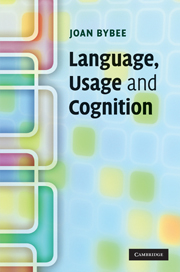Book contents
- Frontmatter
- Contents
- List of figures
- List of tables
- Acknowledgements
- 1 A usage-based perspective on language
- 2 Rich memory for language: exemplar representation
- 3 Chunking and degrees of autonomy
- 4 Analogy and similarity
- 5 Categorization and the distribution of constructions in corpora
- 6 Where do constructions come from? Synchrony and diachrony in a usage-based theory
- 7 Reanalysis or the gradual creation of new categories? The English Auxiliary
- 8 Gradient constituency and gradual reanalysis
- 9 Conventionalization and the local vs. the general: Modern English can
- 10 Exemplars and grammatical meaning: the specific and the general
- 11 Language as a complex adaptive system: the interaction of cognition, culture and use
- Notes
- Bibliography
- Index
4 - Analogy and similarity
Published online by Cambridge University Press: 05 June 2012
- Frontmatter
- Contents
- List of figures
- List of tables
- Acknowledgements
- 1 A usage-based perspective on language
- 2 Rich memory for language: exemplar representation
- 3 Chunking and degrees of autonomy
- 4 Analogy and similarity
- 5 Categorization and the distribution of constructions in corpora
- 6 Where do constructions come from? Synchrony and diachrony in a usage-based theory
- 7 Reanalysis or the gradual creation of new categories? The English Auxiliary
- 8 Gradient constituency and gradual reanalysis
- 9 Conventionalization and the local vs. the general: Modern English can
- 10 Exemplars and grammatical meaning: the specific and the general
- 11 Language as a complex adaptive system: the interaction of cognition, culture and use
- Notes
- Bibliography
- Index
Summary
Analogy and similarity in the processing of novel utterances
So far we have discussed sequential chunks of linguistic material that are stored and accessed whole. We have also mentioned the gradience in the sequential associations which depends upon how often a particular transition within the sequence occurs. Constructions are formed by chunking, but their parts are not invariant: constructions contain schematic positions that encompass sets of items that have been sorted into categories. Earlier we saw how such categories within constructions are built up from experience in an exemplar model. We will say more in Chapter 5 about what has been found through empirical investigations of the nature of these categories, but for the moment we need to consider what type of processing mechanism allows the schematic positions in constructions to be used productively – that is, with new lexical items – and consequently to grow and change.
An important source of creativity and productivity in language that allows the expression of novel concepts and the description of novel situations is the ability to expand the schematic slots in constructions to fill them with novel lexical items, phrases or other constructions. Considerable evidence indicates that this process refers to specific sets of items that have been previously experienced and stored in memory. A number of researchers have used the term ‘analogy’ to refer to the use of a novel item in an existing pattern, based on specific stored exemplars (Skousen 1989, Eddington 2000, Baayen 2003, Boas 2003, Krott, Baayen and Schreuder 2001, Bybee and Eddington 2006).
- Type
- Chapter
- Information
- Language, Usage and Cognition , pp. 57 - 75Publisher: Cambridge University PressPrint publication year: 2010
- 1
- Cited by



